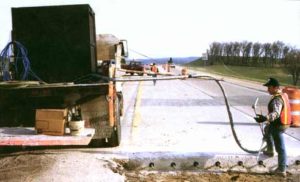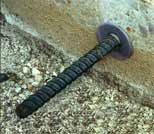The paving industry’s lack of quality control for dowel installation is jeopardizing road qualityBy John Trout Finally, they have succeeded. Today, strict performance specifications for epoxy injection are common throughout the industry. As cores become the measure of performance, skilled and reputable contractors are beginning to dominate the industry. The technology is maturing. The paving industry should learn from this experience. Throughout the country, adhesive anchors and dowels are installed with insufficient quality control. The result is poor load transfer at joints and patches, and premature pavement failure.
Dowels must be properly installed to transfer loads at joints and patches Performance seldom confirmedQuality control measures for dowel installation often consist of little more than an occasional visit by an inspector who looks over the shoulders of the installers to make sure they add more epoxy if a socket is not full at its mouth. The epoxy is often “added” by smearing it around the opening with a stick. Later, the inspector may walk across the bars to see if any of them rattle. In many cases, workers do not insert adhesive into the socket before installing the bar. Rather they dip the bar into a pail of epoxy then insert it into the hole Although some resin may cling to the bar, most of it is scraped off at the mouth of the hole and falls to the ground. Considering some contractors’ methods of mixing epoxy, failing to get epoxy into the hole may be a blessing in disguise. Some workers find that dipping the bar into the pail is a convenient way to mix the epoxy components. They will manually mix the epoxy at 15 to 20 rpm, oblivious to the fact that the manufacturer recommends mixing the epoxy with a drill and paddle at 400 to 600 rpm. Instead of having a uniform gray color, the mixed epoxy looks like a zebra. The resulting product makes a good lubricant, not an adhesive. On many airport and highway construction sites in the United States, few, if any, cores are taken to confirm the full encapsulation of anchors and dowels, much less the full cure of the adhesive. On fast-track repair projects especially, many anchors are not fully encapsulated. This may be due to insufficient resin being dispensed into the socket, or the resin draining from the socket later (Figure 1). The drainage problem is especially troublesome when temperatures are cool in the morning and soar later in the day, reducing a stiff gel to a self-leveling product. These problems are easy to solve. Using a dispenser capable of repeatedly delivering a precise volume of epoxy (called “shot-sizing”) ensures the correct amount of material. Sliding a grout retaining disc over the dowel prevents the epoxy from running out of the hole (Figure 2).
Figure 1. An all-too-common sight: An improperly mixed epoxy lies in a puddle beneath a dowel
These problems are easy to solve. Using a dispenser capable of repeatedly delivering a precise volume of epoxy (called “shot-sizing”) ensures the correct amount of material. Sliding a grout retaining disc over the dowel prevents the epoxy from running out of the hole (Figure 2).
Figure 2. Sliding a grout retaining Disc over the dowel prevents the epoxy from running out of the hole
Empowering the contractorInstalling a properly measured and mixed epoxy into a 10-inch deep horizontal hole in concrete is not rocket science. Almost any contractor could perform such a task without being told the dispenser, mixer, and methods to use. A contractor should be allowed to measure the epoxy components with scoop shovels and mix them with broom handles as long as a properly cured adhesive fully encapsulates the anchor. To the extent feasible, the specification should read: “Contractor’s option — and responsibility.” Nothing will motivate the contractor to install quality control measures faster than knowing that core samples of the work will be the criterion for acceptance. The cores should be taken from the top of the slab and intersect the bars at random distances from the edge of the slab. Two-inch-diameter cores are sufficient. If the bar is fully encapsulated with a properly cured epoxy, the core will break off near the bond line between the concrete and epoxy. If there is a void between the concrete and the dowel, the core will contain the clean interior wall of the socket. If the adhesive is gummy, remnants of it will be found on the end of the core. Penalties for poor performance should be strict. There is no excuse for being unable to perform such an utterly simple, but very important, chore. For a copy of this document in printable PDF format, please download
|




